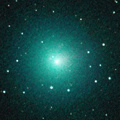
|
It approached to Earth down to 0.3 a.u. in mid February, and brightened up to 5.5 mag (Feb. 13, Juan Jose Gonzalez). Now it is fading. But it is still bright as 8.7 mag (Mar. 11, Marco Goiato). In the Northern Hemisphere, it is observable in excellent condition. It locates low in the Southern Hemisphere.
Date(TT) R.A. (2000) Decl. Delta r Elong. m1 Best Time(A, h)
Mar. 16 4 38.56 33 52.4 1.210 1.401 78 9.6 19:31 ( 99, 60)
Mar. 23 4 30.71 33 33.6 1.446 1.445 69 10.2 19:38 (102, 51)
|

|
It approached to Earth down to 0.08 a.u. in mid December, and it brightened up to 3.4 mag (Dec. 14, Seiichi Yoshida). it looked so large as 3 times of Moon. Now it is fading. It has already faded down to 10.6 mag (Mar. 9, Juan Jose Gonzalez). In the Northern Hemisphere, it stays observable in excellent condition. In the Southern Hemisphere, it stays low for a while.
Date(TT) R.A. (2000) Decl. Delta r Elong. m1 Best Time(A, h)
Mar. 16 9 46.85 40 44.1 0.726 1.584 133 11.9 22:13 (180, 85)
Mar. 23 9 51.96 38 27.1 0.814 1.644 130 12.6 21:50 (180, 87)
|

|
It brightened up to 7.7 mag in June (June 19, Juan Jose Gonzalez). Now it is fading. But it is still bright as 11.2 mag (Mar. 4, Chris Wyatt). In the Southern Hemisphere, it stays observable in good condition for a long time until the comet will fade out. In the Northern Hemisphere, it is not observable for a long time until autumn when the comet fades out down to 16 mag.
Date(TT) R.A. (2000) Decl. Delta r Elong. m1 Best Time(A, h)
Mar. 16 4 6.47 -55 25.6 3.387 3.276 75 12.0 19:31 ( 24, -8)
Mar. 23 4 16.91 -52 30.4 3.458 3.330 74 12.1 19:38 ( 29, -8)
|

|
Now it is 13.5 mag (Jan. 27, Toshihiko Ikemura, Hirohisa Sato). It will be unobservable temporarily soon. But it will appear in the morning sky again at 13-14 mag in August.
Date(TT) R.A. (2000) Decl. Delta r Elong. m1 Best Time(A, h)
Mar. 16 1 24.14 8 24.2 2.846 2.019 27 12.4 19:31 ( 94, 9)
Mar. 23 1 40.02 9 42.9 2.875 2.016 24 12.4 19:38 ( 98, 6)
|
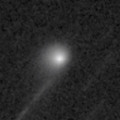
|
Now it is 14.3 mag (Feb. 21, Thomas Lehmann). It will brighten up to 10-11 mag in autumn. It will be unobservable temporarily in March.
Date(TT) R.A. (2000) Decl. Delta r Elong. m1 Best Time(A, h)
Mar. 16 1 24.18 -14 51.8 4.719 3.874 28 13.3 19:31 ( 75, -5)
Mar. 23 1 28.54 -13 11.9 4.719 3.836 24 13.2 19:38 ( 81,-10)
|

|
Now it is 12.3 mag (Mar. 5, Marco Goiato). It is observable in excellent condition in the Northern Hemisphere. It locates low in the Southern Hemisphere.
Date(TT) R.A. (2000) Decl. Delta r Elong. m1 Best Time(A, h)
Mar. 16 11 14.04 31 21.1 1.229 2.149 150 13.4 23:38 ( 0, 86)
Mar. 23 11 8.88 30 36.5 1.259 2.157 145 13.5 23:06 ( 0, 85)
|

|
Now it is 13.3 mag (Feb. 9, Chris Wyatt). It stays 13-14 mag until summer.
Date(TT) R.A. (2000) Decl. Delta r Elong. m1 Best Time(A, h)
Mar. 16 17 29.93 -24 17.2 3.114 3.297 91 13.6 4:46 (341, 28)
Mar. 23 17 26.49 -26 0.4 2.997 3.308 99 13.6 4:36 (347, 28)
|
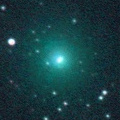
|
Now it is 12.5 mag (Feb. 27, S. Szabo). It will be fading gradually after this. In the Northern Hemisphere, it stays observable for a long time until it fades out. But it stays extremely low. It will never be observable again in the Southern Hemisphere.
Date(TT) R.A. (2000) Decl. Delta r Elong. m1 Best Time(A, h)
Mar. 16 23 2.39 40 48.7 2.771 2.164 43 13.6 4:46 (230, 15)
Mar. 23 23 24.85 42 1.8 2.850 2.218 42 13.9 4:36 (229, 15)
|

|
It is not observable now. It will appear in the morning sky in May.
Date(TT) R.A. (2000) Decl. Delta r Elong. m1 Best Time(A, h)
Mar. 16 23 48.88 5 17.9 6.751 5.767 7 13.9 19:31 (106,-12)
Mar. 23 23 54.18 5 55.1 6.757 5.767 6 13.9 4:36 (253,-12)
|

|
It brightened up to 9.0 mag from autumn to winter (Nov. 16, Maik Meyer). Now it is fading. But it is bright as 12.4 mag still now (Feb. 23, Seiichi Yoshida). It is observable in excellent condition in the Northern Hemisphere. It stays low in the Southern Hemisphere.
Date(TT) R.A. (2000) Decl. Delta r Elong. m1 Best Time(A, h)
Mar. 16 5 41.51 24 18.6 1.775 2.049 90 13.9 19:31 ( 65, 69)
Mar. 23 5 55.57 23 54.8 1.900 2.102 87 14.3 19:38 ( 70, 65)
|
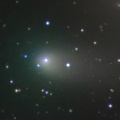
|
It brightened up to 9.5 mag from autumn to winter (Dec. 14, Marco Goiato). Now it is fading. But it is bright as 12.6 mag still now (Feb. 23, Seiichi Yoshida). In the Northern Hemisphere, it stays observable in good condition for a long time until it fades out. It locates low in the Southern Hemispehre.
Date(TT) R.A. (2000) Decl. Delta r Elong. m1 Best Time(A, h)
Mar. 16 8 39.05 44 11.2 1.507 2.200 121 14.0 21:05 (180, 81)
Mar. 23 8 45.10 43 4.3 1.619 2.256 117 14.4 20:44 (180, 82)
|

|
Now it is 13.3 mag (Feb. 20, Thomas Lehmann). It will be fading after this.
Date(TT) R.A. (2000) Decl. Delta r Elong. m1 Best Time(A, h)
Mar. 16 5 35.56 -20 53.4 3.524 3.628 87 14.1 19:31 ( 25, 30)
Mar. 23 5 34.10 -20 33.9 3.666 3.674 82 14.2 19:38 ( 33, 27)
|
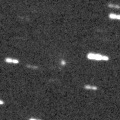
|
Now it is bright as 13.5 mag (Mar. 3, Taras Prystavski). It stays 14 mag for a long time in 2019. In the Southern Hemisphere, it is observable in excellent condition. In the Northern Hemisphere, it is not observasble until summer in 2020.
Date(TT) R.A. (2000) Decl. Delta r Elong. m1 Best Time(A, h)
Mar. 16 8 52.59 -60 18.0 2.724 3.199 109 14.2 21:16 ( 0, -5)
Mar. 23 8 32.03 -59 57.7 2.728 3.179 107 14.2 20:28 ( 0, -5)
|

|
Now it is 15.2 mag (Feb. 1, Toshihiko Ikemura, Hirohisa Sato).It will be fading slowly after this. It is observable in good condition in the Northern Hemisphere. In the Southern Hemisphere, it stays extremely low for a while.
Date(TT) R.A. (2000) Decl. Delta r Elong. m1 Best Time(A, h)
Mar. 16 16 2.54 46 36.5 3.662 4.083 108 14.7 4:30 (180, 78)
Mar. 23 15 59.35 47 13.4 3.680 4.134 110 14.7 4:00 (180, 78)
|

|
Now it is 14.5 mag (Aug. 16, P. Camilleri, H. Williams). It stays 15 mag from 2018 to 2019, and it will be observable for a long time in the Southern Hemisphere. In the Northern Hemisphere, it will never be observable again.
Date(TT) R.A. (2000) Decl. Delta r Elong. m1 Best Time(A, h)
Mar. 16 22 49.64 -53 6.7 4.469 3.938 52 14.9 4:46 (316,-32)
Mar. 23 23 1.38 -52 0.6 4.438 3.944 54 14.9 4:36 (315,-31)
|

|
Now it is 14.9 mag (Mar. 1, Toshihiko Ikemura, Hirohisa Sato). It will be fading slowly after this. It is observable in excellent condition until spring in the Northern Hemispehre. In the Southern Hemisphere, it will be hardly observable after this.
Date(TT) R.A. (2000) Decl. Delta r Elong. m1 Best Time(A, h)
Mar. 16 9 27.64 43 22.5 4.340 5.028 129 14.9 21:52 (180, 82)
Mar. 23 9 17.74 42 43.8 4.463 5.067 122 15.0 21:15 (180, 82)
|
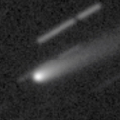
|
Now it is 13.5 mag (Mar. 4, Chris Wyatt). It will be fading after this, and it will be fainter than 18 mag in May.
Date(TT) R.A. (2000) Decl. Delta r Elong. m1 Best Time(A, h)
Mar. 16 11 30.46 -5 12.2 0.873 1.864 172 15.0 23:55 ( 0, 50)
Mar. 23 11 26.33 -4 35.0 0.908 1.896 169 15.3 23:23 ( 0, 50)
|

|
Now it is 14.2 mag (Feb. 4, ATLAS-MLO, Mauna Loa). It will be fading gradually after this. It is observable in excellent condition in the Northern Hemisphere. In the Southern Hemisphere, it is not observable until summer.
Date(TT) R.A. (2000) Decl. Delta r Elong. m1 Best Time(A, h)
Mar. 16 9 27.43 70 42.5 1.876 2.380 108 15.2 21:53 (180, 55)
Mar. 23 9 24.90 67 50.3 1.945 2.417 105 15.3 21:23 (180, 57)
|

|
Now it is 13.6 mag (Feb. 27, S. Szabo). It is expected to brighten up to 7-8 mag in 2020. It will be unobservable temporarily in April.
Date(TT) R.A. (2000) Decl. Delta r Elong. m1 Best Time(A, h)
Mar. 16 3 7.19 3 36.4 5.562 5.009 51 15.2 19:31 ( 75, 27)
Mar. 23 3 10.34 4 27.0 5.586 4.946 46 15.2 19:38 ( 80, 21)
|
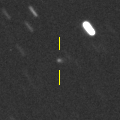
|
It is expected to brighten up to 10 mag in autumn. Now it is 16.5 mag (Feb. 27, Thomas Lehmann). In the Northern Hemisphere, it stays observable for a long time while the comet is brightening. In the Southern Hemisphere, it it not observable until mid September.
Date(TT) R.A. (2000) Decl. Delta r Elong. m1 Best Time(A, h)
Mar. 16 1 13.28 87 25.4 2.540 2.723 89 15.9 19:31 (177, 35)
Mar. 23 2 20.80 84 16.4 2.555 2.653 84 15.8 19:38 (173, 36)
|
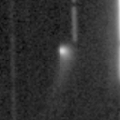
|
Now it is 15.5 mag (Feb. 4, Kunihiro Shima). It will be fading after this. It is observable in good condition in the Northern Hemisphere. It is not observable at all in the Southern Hemisphere.
Date(TT) R.A. (2000) Decl. Delta r Elong. m1 Best Time(A, h)
Mar. 16 3 41.81 59 22.8 3.406 3.329 77 15.9 19:31 (143, 49)
Mar. 23 3 41.03 57 33.3 3.534 3.341 70 16.0 19:38 (139, 45)
|

|
First return of a new periodic comet discovered in 2014. The condition of this apparition is excelllent. It was expected to brighten rapidly, and to be observable at 15.5 mag in excellent condition in March. But it has not been recovered yet. Now it is not detected, fainter than 20.0 mag (Dec. 10, Toshihiko Ikemura, Hirohisa Sato).
Date(TT) R.A. (2000) Decl. Delta r Elong. m1 Best Time(A, h)
Mar. 16 10 8.15 11 2.5 0.799 1.753 155 16.0 22:33 ( 0, 66)
Mar. 23 10 6.61 11 34.4 0.811 1.737 147 15.9 22:04 ( 0, 67)
|

|
Although it was faint as 16-17 mag in November, it brightened up to 14.7 mag in December (Dec. 12, Toshihiko Ikemura, Hirohisa Sato). It is bright as 15.1 mag still now (Jan. 31, Toshihiko Ikemura, Hirohisa Sato). In the Northern Hemisphere, it stays observable in excellent condition after this. It stays extremely low in the Southern Hemisphere.
Date(TT) R.A. (2000) Decl. Delta r Elong. m1 Best Time(A, h)
Mar. 16 10 43.47 43 14.3 2.255 3.058 136 16.4 23:08 (180, 82)
Mar. 23 10 38.31 42 55.6 2.331 3.088 132 16.6 22:36 (180, 82)
|
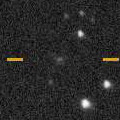
|
Now it is 17.4 mag (Jan. 3, Toshihiko Ikemura, Hirohisa Sato). It stays 16 mag for a long time from 2019 to 2020. It is observable in excellent condition in the Southern Hemisphere. It is hardly observable in the Northern Hemisphere.
Date(TT) R.A. (2000) Decl. Delta r Elong. m1 Best Time(A, h)
Mar. 16 13 50.56 -52 43.8 3.621 4.193 118 16.5 2:20 ( 0, 2)
Mar. 23 13 39.60 -54 15.2 3.528 4.158 123 16.4 1:41 ( 0, 1)
|

|
Now it is 16.8 mag (Jan. 31, Toshihiko Ikemura, Hirohisa Sato). It stays 16-17 mag for a long time until 2020. It is observable in good condition in the Northern Hemisphere. It is not observable at all in the Southern Hemisphere.
Date(TT) R.A. (2000) Decl. Delta r Elong. m1 Best Time(A, h)
Mar. 16 11 14.22 74 4.7 8.088 8.446 107 16.7 23:39 (180, 51)
Mar. 23 11 7.65 73 47.1 8.135 8.447 104 16.7 23:05 (180, 51)
|
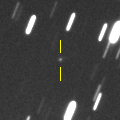
|
Now it is 16.6 mag (Feb. 1, Toshihiko Ikemura, Hirohisa Sato). It continues brightening even after the perihelion passage. It stays observable at 16-17 mag in good condition for some more time.
Date(TT) R.A. (2000) Decl. Delta r Elong. m1 Best Time(A, h)
Mar. 16 8 21.51 -1 34.9 0.975 1.785 129 16.9 20:47 ( 0, 53)
Mar. 23 8 29.04 -1 14.1 1.042 1.814 125 17.0 20:27 ( 0, 54)
|

|
Now it is 16.8 mag (Feb. 1, Toshihiko Ikemura, Hirohisa Sato). It is observable at 17 mag in good condition in 2019. It locates somewhat low in the Northern Hemisphere.
Date(TT) R.A. (2000) Decl. Delta r Elong. m1 Best Time(A, h)
Mar. 16 15 57.28 -16 28.4 3.285 3.802 114 17.0 4:25 ( 0, 38)
Mar. 23 15 57.68 -16 29.8 3.200 3.810 120 17.0 3:58 ( 0, 38)
|

|
It brightened up to 6.8 mag in September (Sept. 17, Seiichi Yoshida). Now it is fading. But it is still bright as 15.7 mag (Mar. 4, Katsumi Yoshimoto).
Date(TT) R.A. (2000) Decl. Delta r Elong. m1 Best Time(A, h)
Mar. 16 6 26.77 -13 41.9 2.062 2.449 100 17.0 19:31 ( 12, 41)
Mar. 23 6 33.58 -11 59.7 2.187 2.508 96 17.3 19:38 ( 21, 41)
|
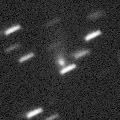
|
It brightened up to 8.7 mag in July (July 18, Marco Goiato). Now it is 19.9 mag (Feb. 28, Jean-Francois Soulier). It stays observable in good condition after this while the comet will be fading. But actually, it is fainter than this ephemeris.
Date(TT) R.A. (2000) Decl. Delta r Elong. m1 Best Time(A, h)
Mar. 16 16 23.31 -10 21.8 3.156 3.600 108 17.1 4:46 (358, 45)
Mar. 23 16 19.56 -9 2.1 3.124 3.679 116 17.1 4:20 ( 0, 46)
|

|
Now it is 17.1 mag (Feb. 28, Thomas Lehmann). It is expected to be observable at 5-6 mag for a long time from 2022 to 2023. It will be observable in good condition for a long time in the Southern Hemisphere. In the Northern Hemisphere, it is not observable at the highlight from 2022 summer to 2023 summer.
Date(TT) R.A. (2000) Decl. Delta r Elong. m1 Best Time(A, h)
Mar. 16 18 13.43 54 32.9 12.079 12.067 86 17.2 4:46 (217, 62)
Mar. 23 18 13.91 55 1.1 12.009 12.022 88 17.2 4:36 (213, 64)
|

|
Now it is 17.2 mag (Feb. 2, Toshihiko Ikemura, Hirohisa Sato). Fading slowly. It stays observable at 17 mag in good condition until summer.
Date(TT) R.A. (2000) Decl. Delta r Elong. m1 Best Time(A, h)
Mar. 16 11 35.12 8 59.9 9.046 10.034 172 17.2 0:04 ( 0, 64)
Mar. 23 11 33.63 9 19.0 9.072 10.046 167 17.3 23:31 ( 0, 64)
|
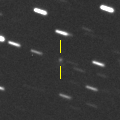
|
Now it is 17.2 mag (Feb. 1, Kunihiro Shima). It stays 17 mag from spring to summer. But it is hardly observable. In the Northern Hemisphere, it is observable only until May. In the Southern Hemisphere, it stays locating extremely low.
Date(TT) R.A. (2000) Decl. Delta r Elong. m1 Best Time(A, h)
Mar. 16 4 38.81 43 11.1 2.474 2.504 80 17.5 19:31 (117, 61)
Mar. 23 4 52.12 42 25.6 2.509 2.463 75 17.4 19:38 (116, 57)
|
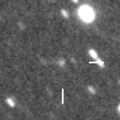
|
Now it is 18.2 mag (Oct. 8, Toshihiko Ikemura, Hirohisa Sato). It will brighten up to 16.5 mag in June. It is observable in excellent condition in the Southern Hemisphere. It locates low in the Northern Hemisphere.
Date(TT) R.A. (2000) Decl. Delta r Elong. m1 Best Time(A, h)
Mar. 16 18 55.78 -25 23.8 4.149 3.961 72 17.6 4:46 (323, 19)
Mar. 23 18 54.91 -26 18.4 3.994 3.937 79 17.5 4:36 (327, 20)
|
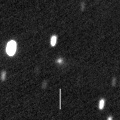
|
Now it is 17.0 mag (Feb. 1, Toshihiko Ikemura, Hirohisa Sato). It will be fading after this, and it will be fainter than 18 mag in May. It locates very low in the Southern Hemisphere.
Date(TT) R.A. (2000) Decl. Delta r Elong. m1 Best Time(A, h)
Mar. 16 5 54.68 42 35.0 3.779 3.972 93 17.6 19:31 (124, 74)
Mar. 23 5 59.65 42 20.6 3.892 3.987 88 17.6 19:38 (118, 69)
|

|
Main-belt asteroid. But it shows a straight tail like a comet. Now it is 17.4 mag (Mar. 4, Katsumi Yoshimoto). It stays observable in excellent condition until early summer.
Date(TT) R.A. (2000) Decl. Delta r Elong. m1 Best Time(A, h)
Mar. 16 10 9.40 -3 19.2 1.387 2.333 156 17.6 22:34 ( 0, 52)
Mar. 23 10 4.89 -1 21.9 1.403 2.318 149 17.7 22:02 ( 0, 54)
|

|
First return of a new periodic comet which brightened up to 16.5 mag in 2005. It will brighten up to 17.5 mag in spring.
Date(TT) R.A. (2000) Decl. Delta r Elong. m1 Best Time(A, h)
Mar. 16 13 19.15 -9 53.9 2.250 3.168 152 17.8 1:48 ( 0, 45)
Mar. 23 13 16.24 -9 39.9 2.189 3.146 160 17.7 1:17 ( 0, 45)
|

|
Now it is 17.1 mag (Feb. 1, Toshihiko Ikemura, Hirohisa Sato). It will be fading after this, and it will be fainter than 18 mag in March.
Date(TT) R.A. (2000) Decl. Delta r Elong. m1 Best Time(A, h)
Mar. 16 7 52.88 20 32.8 2.065 2.719 121 17.8 20:19 ( 0, 75)
Mar. 23 7 55.53 20 4.8 2.168 2.744 115 17.9 19:54 ( 0, 75)
|
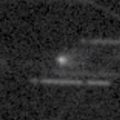
|
Now it is 17.0 mag (Jan. 29, Toshihiko Ikemura, Hirohisa Sato). It will be fading after this, and it will be fainter than 18 mag in March. It locates low in the Southern Hemisphere.
Date(TT) R.A. (2000) Decl. Delta r Elong. m1 Best Time(A, h)
Mar. 16 10 35.94 32 27.0 2.095 2.972 145 17.9 23:01 ( 0, 87)
Mar. 23 10 31.06 32 26.1 2.180 3.011 139 18.0 22:28 ( 0, 87)
|
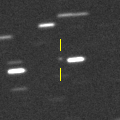
|
Now it is 17.7 mag (Feb. 4, Toshihiko Ikemura, Hirohisa Sato). It is observable at 18 mag in good condition from March to April.
Date(TT) R.A. (2000) Decl. Delta r Elong. m1 Best Time(A, h)
Mar. 16 14 29.17 13 55.7 1.931 2.742 136 17.9 2:58 ( 0, 69)
Mar. 23 14 24.77 14 60.0 1.931 2.788 142 17.9 2:26 ( 0, 70)
|

|
It was observed at 16 mag from 2017 to 2018. Now it is fading. It is observable at 18 mag in good condition in this spring.
Date(TT) R.A. (2000) Decl. Delta r Elong. m1 Best Time(A, h)
Mar. 16 16 8.29 7 29.5 6.987 7.436 113 17.9 4:36 ( 0, 62)
Mar. 23 16 7.72 8 21.7 6.927 7.465 119 17.9 4:08 ( 0, 63)
|

|
It has not been observed yet in this apparition. It passed only 0.08 a.u. from Sun on Jan. 31. In the Northern Hemisphere, it is observable at 18 mag in excellent condition in March. It locates extremely low in the Southern Hemisphere.
Date(TT) R.A. (2000) Decl. Delta r Elong. m1 Best Time(A, h)
Mar. 16 16 30.82 50 56.5 0.493 1.203 102 17.9 4:46 (189, 74)
Mar. 23 14 55.83 53 55.1 0.552 1.329 115 18.1 2:59 (180, 71)
|
|
![]()
 C/2017 T2 ( PanSTARRS )
C/2017 T2 ( PanSTARRS ) C/2018 W2 ( Africano )
C/2018 W2 ( Africano ) C/2018 A3 ( ATLAS )
C/2018 A3 ( ATLAS ) P/2014 C1 ( TOTAS )
P/2014 C1 ( TOTAS ) 240P/NEAT
240P/NEAT C/2018 F4 ( PanSTARRS )
C/2018 F4 ( PanSTARRS ) C/2010 U3 ( Boattini )
C/2010 U3 ( Boattini ) 239P/LINEAR
239P/LINEAR 74P/Smirnova-Chernykh
74P/Smirnova-Chernykh 21P/Giacobini-Zinner
21P/Giacobini-Zinner C/2017 T3 ( ATLAS )
C/2017 T3 ( ATLAS ) C/2017 K2 ( PanSTARRS )
C/2017 K2 ( PanSTARRS ) C/2014 B1 ( Schwartz )
C/2014 B1 ( Schwartz ) C/2018 X2 ( Fitzsimmons )
C/2018 X2 ( Fitzsimmons ) C/2018 KJ3 ( Lemmon )
C/2018 KJ3 ( Lemmon ) 159P/LONEOS
159P/LONEOS (6478) Gault
(6478) Gault P/2018 X1 ( LONEOS )
P/2018 X1 ( LONEOS ) 59P/Kearns-Kwee
59P/Kearns-Kwee 164P/Christensen
164P/Christensen 49P/Arend-Rigaux
49P/Arend-Rigaux C/2017 E3 ( PanSTARRS )
C/2017 E3 ( PanSTARRS ) (394130) 2006 HY51
(394130) 2006 HY51![]()




































